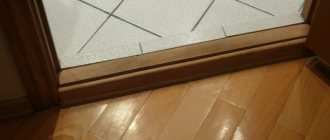There are situations when the door to the bathroom does not open. It is especially unpleasant when someone is locked inside. To avoid knocking down the door in a panic, you can disassemble the lock mechanism. There are many reasons why a lock can jam, including a displaced latch, a key that is stuck in the hole, a jammed tongue, and a faulty lock.
In addition, the bathroom area is characterized by high humidity, which can lead to swelling of the wooden door panel, which will also affect its ease of opening.
How to open the door to the bathroom ↑
There can be many reasons why the door slams shut and does not respond to usual manipulations. For modern models with a built-in lock, the most common problem is a latch that has moved out of place, a jammed tongue, a key stuck in the hole, or a broken lock. Wooden structures without a lock often swell from excess moisture and can jam.
A ruler, knife or plastic card will help you open the door.
Reasons for slamming shutters
Before you start taking any action, you need to find out the reason why the door cannot be opened. Probable reasons:
- the lock in the door handle is jammed or broken;
- the latch did not fit into the hole and moved;
- the tongue does not come out, it is jammed;
- the key left on the back side prevents the door from opening.
To accurately identify the cause, you need to use a flat screwdriver to slightly lift the blade in several places. If you move the raised sash, you can determine in which area it is held. After accurately locating the jammed location, you can choose specific actions.
If the tongue is jammed ↑
Most locks are equipped with a special spring-loaded latch. If the spring fails, the tongue stops moving and supports the door leaf. To release it, the part must be squeezed out or simply moved aside. The easiest way to do this is from the side where the door opens.
Any flat and thin object will come to our aid: a rounded table knife, a thin chisel, a ruler, a flat screwdriver, a plastic card, etc.
- We insert the tool into the gap between the jamb and the canvas in the place where the tongue is located.
- We tilt the tool towards the door handle while pressing it. If everything goes correctly, you can feel the tool sliding along the cut of the tongue.
- Now you need to press it away from you so that the tongue can go into the lock. Pull the door towards you or push it, depending on where it opens.
If you have to open the structure from the side where the tongue does not have a cut, insert the tool from above. Then we tilt it diagonally to reach the inside of the lock. Now press the tongue firmly.
You can open the door without a key using wire or hairpins
Installing a Latch Door Handle
Even if the handle was not completely dismantled, everything will have to be returned to its previous state. Therefore, you need to know not only how to remove, but also how to install the handle on an interior door with a latch.
The whole process is conventionally divided into three main steps: marking, making holes, direct installation and fastening . Each company may have nuances in installation, so step-by-step instructions are attached to any fittings.
Tools
Each master approaches any work from his own perspective, so the tool will be different, but the standard is as follows: a spiral and a feather drill, a chisel, a wood crown. A pencil, a screwdriver, a ruler, a drill, and a tape measure will also come in handy.
Tool for opening a jammed lock
Marking
Most often, door manufacturers indicate a place for the handle, and it is advisable to install it there. Take a distance of 80-120 cm from the floor , and if there are other door panels nearby, then the handles will look more advantageous at the same distance.
An angle is applied to the door at the selected height and a line is drawn. Next, mark the place for the tongue of the handle, mark it on both sides and put a mark for the future hole.
Drilling
Using a tool with a wood bit, a hole is drilled on one side, but not through, and then finally on the other.
The hole for the tongue is prepared using a guide drill. This part of the work is done most carefully, because there is very little space left to the edge of the door leaf . Knock out excess wood from the canvas with a chisel, periodically applying the lock plate in order to correctly place the plate in the same plane with the door end.
Key on the other side of the door ↑
Interior doors, and even more so bathroom doors, are rarely equipped with a lock and key. However, this also happens. Problems with such locks seem to be the most difficult. And indeed: to solve them, the most important thing is not to rush. Any careless movement, irritation and anger can only aggravate the situation. If the key is simply jammed, do not yank it with all your expression, it may simply break and then it will be even more difficult to open the door.
If the door slams and the key remains outside, we will act carefully. Our goal is to get the key from the lock. Place a cloth or newspaper under the door (at the location of the lock, of course) and try to knock out the key with gentle pushes. If this does not help, any thin object that can be used to push the key into the keyhole will come to the rescue - a knitting needle, a needle, a paper clip or wire. As soon as you hear that the key has fallen out, pull it on the newspaper towards you through the crack under the door. Ready!
Opening the lock with a hairpin
A broken lock can be opened with something as simple as a hairpin. You could see such a picture more than once in the movies. But in real life, not everything is so simple; this method is not suitable for all locks.
You can try to open the lock with a thick wire
The pin needs to be divided into two parts, one of which must be threaded into the lock, and the other one should try to move the pins, while simultaneously turning the lock first. Instead of a hairpin, a strong wire will also work, but it must be used carefully so that its parts do not remain in the lock.
When opening a lever lock with a wire, you need to pull it towards you as hard as possible and try to move the levers.
The key broke in the lock ↑
When the key is stuck in the lock, we usually try to somehow turn it. And sometimes this ends in disaster - the key breaks and remains in the lock. First of all, try to avoid such a situation by using the tips above. But if this does happen, look around to see what you can use. Pulling out a broken key is much more difficult than squeezing out the tongue or knocking out the key from the other side.
Outside ↑
If you are outside, then the easiest, fastest and most relaxing method to solve the problem of a broken key is to simply disassemble the lock using a screwdriver. But that's if you have the tools at hand. What if you stayed inside?
From the inside ↑
You can wring out a lock with a stuck key using pliers. This option is suitable if at least some part of the key sticks out of the lock, which you can grab onto. In addition to pliers, tweezers are also suitable. Your movements must be careful. If there is an opportunity to lubricate the lock parts with at least something, take advantage of it.
A self-tapping screw will help you remove the broken key from the lock. In this case, you need to hit the end of the key with a self-tapping screw with pinpoint precision, and methodically “drill” a hole with the self-tapping screw, thereby fixing it in the key. And only when you are sure that the screw fits securely enough, you can try to turn the key or use pliers and pull out the fragment.
As a last resort, try using the same knitting needles, wire, needles, awls and any other thin tools that can be used to “grab” a piece of the key in the keyhole and loosen it. It is advisable to lubricate the tools and the lock before doing this.
Preventive measures
To avoid such situations, a number of preventive measures need to be taken:
- The locking mechanisms on the doors should be well looked after (carry out routine repairs, check their functionality and lubricate them on time).
- Jamming devices should be replaced immediately.
- Have a spare set of keys for all doors. Provide them with tags.
- Do not install complex locking mechanisms on doors unless necessary. Sometimes you can give preference to simple bolts, latches and latches (especially if there are small children in the family).
- It is recommended to purchase locks that are equipped with devices for emergency door opening.
Timely preventive measures can eliminate unnecessary problems with interior doors.
How to open a door without a key ↑
For example, the key is somewhere in the apartment, and you are sitting in a locked bathroom. How to open a door without a key? In this case, we will try ourselves in the role of real burglars. Hairpins, knitting needles, wire, a thin nail file and tweezers, needles and pins will be used. Your goal is to immobilize everything that moves in the castle. As a rule, interior door locks have a fairly simple design, so there are few pressing mechanisms. Slowly feel them from above and below and try to immobilize them. Once this mission is completed, slowly turn the tools in the direction of turning the key. If you win, you will hear a characteristic click
Required Tools
In order to open interior doors without a key, you may need the following tool:
- flat and Phillips screwdrivers;
- hammer;
- pry bar, chisel;
- pliers;
- angle grinder (grinder);
- hacksaw for metal.
If it is not possible to use such tools, then you can use any available means. A straightened paper clip, knitting needle, nail file, or other long metal object will work to open the small round keyhole.
Radical measures: how to knock down a door without damaging it ↑
What if nothing helps you? For example, you are sitting locked in the bathroom and you have absolutely nothing at hand that could help solve the problem. Don't break the door just because the lock is broken? It is possible to knock out or, rather, “squeeze out” the door entirely if it opens outward. First, you need to apply something soft to the shoulder that will have to be “worked,” for example, a rolled up towel. Then we press our shoulder forcefully into the structure, directing the force to the area near the edge of the opening. At the same time, we try to stand so that our feet rest against something, and with our free hand we hold on to the wall so as not to fall when the door opens.
You may also be able to remove the door frames, thereby disassembling the door.
To open doors with glass inserts, simply pull out the decor
For a design with a glass insert, simply remove the decor. To do this, carefully remove the glazing beads that press the glass and take out the decorative fabric. Then we try to open the door through the resulting hole. If you can't remove the glass, you can break it, but try to be patient - you will probably succeed.
By gaining access to both sides of the lock, it is much easier to dismantle or open it.
A wooden panel can jam due to excess moisture. The tree absorbs it even from the air, swells and jams the structure. If this is the case, you can try to speed up the drying of the wood by warming it up with a heater or hairdryer. At the end of the process, it is advisable to trim the problem areas a little so that the unpleasant situation does not recur.
Tongue problem
Another problem: if the mechanism is not equipped with a latch, but the door does not want to open, even if the handle is pressed all the way. Breakage may occur due to improper functioning of the tongue. To solve the problem, you will need a tool with a flat end that will fit into the small gap between the canvas and the box. This tool must be durable so as not to break, as this will further aggravate the situation. A working tool can be a metal ruler or a durable knife.
How to open a door from the inside using improvised means ↑
All of the above tips are suitable for use both outside and inside. The only difference is what tools you can find in the bathroom. Remember that if you don't have pliers, you may have tweezers or tweezers. An awl and wire can replace hairpins. And a file is a nail file. A folded cardboard packaging of cosmetics and a spoon will help you press out the tab in the lock. You can also pick up door frames or glass decor cladding using a nail file or spoon. Get creative - even though you probably don't have a full set of tools in your bathroom, there are probably plenty of items in there that will help you! In all other respects, follow the advice above, based on your situation and the side of the door opening.
We looked at the most common problems with opening bathroom doors. In fact, there are many more of them. You can try to deal with them yourself. However, you need to be firmly confident in the correctness of your actions, otherwise you can only aggravate the situation and lead to damage not only to the lock, but also to the door leaf. If you have doubts about your competence, it is better to invite professionals. They can help open any door structure. And, of course, you should not skimp on locks and fittings in order to initially prevent funny situations.
Was the article useful? Tell your friends:
What to do if you can’t open the lock
It may be that the lock cannot be opened. The door to the bathroom closed from the inside, what should I do? Breaking down the door is the last case, but it doesn’t have to come to that. Try to open it in a civilized way. For this:
- Try to remove the door from its hinges. Carefully inspect the hinges, remove the inner rod. Remove the door in the opposite direction;
- Insert the blade of a knife, ax or nail puller into the gap between the door frame and the door leaf. Try to press the door away from the opening to release the lock tongue;
- After removing the casing, cut out a small part of the area where the crossbar trim is located;
- The situation is easier if the door has glass inserts. They need to be pulled out carefully. If that doesn't work, just break it and you'll gain access to the lock. New glass is easy to install.
After such operations, you will have to put the door in order. It is not recommended to turn the key forcefully, as it can break and make the situation worse.
Possible situations
Lock systems on doors in a house can be completely different. Sometimes a regular handle with a tongue is enough, and in some cases it is necessary to install additional latches and key locks. However, there are situations when the door closes and it is not possible to open it in a simple way. The reasons may be:
- a draft that slammed the lock;
- broken handle;
- sinking tongue;
- push-button mechanism;
- lost key;
- intentional or accidental closing from the inside.
What to do in such cases? The problem can be solved using different methods, depending on the specific situation. The most common ways are:
- use of a handy master key;
- disassembling a lock or handle;
- removal from hinges;
- use of brute force.
Varieties of methods for opening interior doors
If there is a small child left in the room, water or any equipment that could cause a fire is turned on, you need to act immediately.
In emergency situations, most often there is nothing left to do but simply break open the interior door. In this case, damage cannot be avoided, but you will be able to minimize the risk of much more serious consequences.
Door handle repair: step-by-step instructions
When using a door, the greatest load is taken by the handle and the locking mechanism associated with it, so it is not surprising that these elements often break. In most cases, you can repair the door handle yourself using a screwdriver and wrench. Sometimes it is necessary to replace some parts of the mechanism or the entire set.
Removing door handle fasteners
Types of pens
There are three main types of door handles:
- Round rotary. They are an integral part of the mortise lock, which is activated by turning the handle clockwise or counterclockwise.
- Push. The difference from the first point is the presence of a convenient lever handle, which opens the lock when pressed and closes it when returning to its original position. This option is the most convenient for both interior and entrance doors.
- Stationary (usually shaped like a ball or bracket). These handles are not connected to the lock; they perform a decorative function and serve as a handle when opening the door leaf. Repairing this type of door handle involves either tightening loose bolts or replacing it with a new product.
Round rotary handle secured with locking mechanism
Components of the mechanism
When the question arises of how to repair a door handle, the first thing you need to do is familiarize yourself with its structure. For those who have experienced installing a lock on a wooden door, this will not be difficult. Push and rotary handles consist of the following elements:
- Lever.
- Locking mechanism with bolt. Its operating principle is simple - when you turn the handle, the tongue (bolt) enters the counter hole on the door frame and blocks the door.
- Square (pin with a square section). Connects the handle and the lock.
- Decorative strip that masks fasteners.
- Return spring. Responsible for returning the handle to its original position.
- Handle travel limiter.
- Retaining ring.
- Plastic ring.
Elements that make up a door handle
Types of door handle malfunctions and their elimination
If you find that the door handle is broken, you must first determine the cause. Experience in using door handles allows us to identify 5 types of breakdowns that occur most often:
- The handle sticks and there is resistance when turning.
- The handle falls off, but its fastening remains in place.
- The tetrahedral pin (square) inside the lock breaks.
- When turning the handle, the tongue does not move.
- The handle does not return to its original position after turning.
Now let's look at how to repair the door handle in each of these cases.
If the handle gets stuck
The metal parts of the mechanism are subject to abrasion during constant use, especially if dust particles get there. To avoid this, you need to monitor the presence of lubricant in the lock. Drop a little oil onto the bolt and turn the handle so that it is evenly distributed over all parts.
Sometimes the reason lies in loose structural elements. It is necessary to correct their position and tighten the mounting bolts more tightly.
How to properly lubricate the door mechanism
Repair if the handle falls out
The culprit of the breakdown in this case is the retaining ring, which either becomes deformed or moves, or may even burst completely. The repair will take time, but it will not be difficult to do:
- Remove the decorative rosette by turning it several times (sometimes it is secured with a small screw from the bottom, then you need to unscrew it first).
- Using a screwdriver, unscrew the screws or bolts that secure the mechanism.
- Remove the structure and check the condition of the retaining ring. If it is bent or broken (as is the case in most cases), you need to purchase a new spare part.
- Insert the retaining ring and the entire mechanism into place.
- Install the handle and secure it.
Removing the decorative strip and unscrewing the handle fasteners
Repair in case of breakage of the internal tetrahedral pin (square)
This is only possible when using cheap, low-quality products that are made from fragile material - silumin. In this situation, you will have to change the mechanism completely. To avoid such breakdowns, it is better to purchase steel structures from trusted manufacturers. The handle is replaced as follows:
- The fasteners at the base of the handle are unscrewed, then the handle itself is removed.
Unscrewing the screw at the base of the handle
- The decorative strip is unscrewed and the bolts are unscrewed, after which the entire structure is removed.
- At the end of the door, the fasteners on the lock plate are unscrewed, after which the locking mechanism is removed.
- The new handle with lock is installed in the reverse order.
If the tongue does not move when you turn the handle
If the latch does not work when opening the door, the cause of the malfunction is that the square is too short. It gradually moves towards the latch and presses it. As a result, she cannot function normally. In this case, you need to act like this:
- Buy a longer square from the market. If the length is longer than necessary, you can shorten it using a grinder.
- Unscrew one of the handles and remove the structure.
- Replace the square and return the handle to its place.
The handle does not return to its original position
If the handle does not spring back to the horizontal position, this does not mean that it is broken - perhaps the return spring has simply slipped off. You can put it in place in the same way as the locking ring. But sometimes the spring breaks, and this becomes a problem: it is very difficult to purchase this part on the market. Often in such cases the entire mechanism is changed.
Spring responsible for returning the door handle to its original position
Prevention
To ensure that the operation of the lock lasts as long as possible, and the mechanism itself does not unexpectedly jam, try to follow the following recommendations:
- Special protective linings allow you to prevent small debris, dust and peeling coating from getting into the keyhole;
- The key must be used only for its intended purpose. They should not open bottles, tear protective film, packaging, open or pry mailbox doors, etc.;
- Once every six months, lubricate the well with lubricants specially designed for this purpose;
- Regularly check the well for the presence of foreign objects (matches, chewing gum, plasticine) and damage;
- Constantly check the grooves and protrusions of the key for integrity; if you notice wear or deformation, it is recommended to order a new key;
- Order duplicate keys from trusted workshops. Firstly, this will protect you from products made of low-quality, soft metals, which will quickly wear off and clog the wells with metal shavings. Secondly, there is a lower chance of running into an unscrupulous craftsman collaborating with criminals;
- It is worth periodically inspecting the appearance of the door structure for distortions and damage to the hinges;
- If you detect the first signs of a malfunction of the mechanism (extraneous sounds, creaking when turning the key, turning the key in the hole, the use of force when closing/opening or during the process of inserting/removing the key from the hole), it is recommended to seek help from a specialist or independently adjust the operation of the lock if you have similar skills.
Compliance with the above recommendations will allow you to detect an emerging problem in time and solve it calmly, without unnecessary nerves, since it is not always possible to open a jammed lock in a matter of minutes. In addition, not everyone has repair skills, so in most cases a specialist is called in who can open a faulty lock without damaging the front door. The master cannot always arrive in a short time, so there is a possibility of waiting outside the apartment for his arrival, which is very nerve-wracking, especially if the owner is in a hurry. We hope that thanks to the information in this article, you understood how to open a jammed door. By applying your knowledge in practice, you can easily open a jammed lock without damaging the door leaf.
Possible methods
Latch offset
One of the effective methods of opening the door to a room. Basically, models installed in openings inside the home have a push or turn handle.
- Without a lock. The most convenient locks to open. It is enough to press the tongue and the door will open. When installing the block, there is always a small gap between the canvas and the box. All you need to do is press the sash a little, insert a flat, hard object into the slot and try to move the latch. As a rule, it gives in easily, and if you pull the door towards you, it will open. What can you use? A nail file, a kitchen knife, a screwdriver with a thin blade, or something similar. For lack of anything better, a bank (plastic) card will also come in handy.
If the child has locked the latch from the inside (for example, the door to the bathroom), but for some reason cannot move it on his own (or simply fell asleep), then this method is also suitable for such a situation. By “playing” with the door a little, you will be able to dislodge the lock and enter the room.
- With a lock. These models, if they were not installed independently, with a security key, can be opened easily. The mechanism is turned by any flat and narrow object - the same thin screwdriver, wire loop, paper clip, hair clip. It is enough to insert the “tool” into the well, and after two or three attempts the valve will open.
Some interior door locks have a button-shaped plug. It is necessary to grab its “head” with pliers and turn it in the desired direction. The latch will definitely move.
Opening the lock
Some owners equip interior doors with lever and cylinder locking mechanisms. How to open such a lock without a key? It's not a fact that it will work, but it's worth a try.
If the interior door slams, then first you should pull it a little. The bolts in the simplest models of locks, as a rule, bounce off and the sash is unlocked.
- Try to open the lock with a key of a similar configuration. If the mechanism is very worn, then most likely it will work.
- Knock out or drill out the cylinder.
- Disassemble the handle and move the valve bar from the inside.
When choosing a technique, you need to focus on the design features of the lock. But at least one of them will definitely help if there is no simpler option.
Dismantling
If you cannot open the interior door lock without a key, you will have to choose this method. The nuance is that it is not always possible to implement it. Canopies differ in design and installation specifics, and if they are hidden, then this is not an option.
Basically, to fasten the doors of interior models, card-type hinges in various designs are used (hinged, “butterfly” and a number of others). What they have in common is that they are fixed to the frame and jamb using self-tapping screws. It is enough to unscrew the fasteners on one side of each hinge, move the door slightly (so that the latch tongue comes out of the bar), and the door will easily be removed from the opening.
Reasons for lock jamming
Any lock can jam, regardless of cost, design, quality and service life. The most common causes of constipation are:
- Lack of timely maintenance - cleaning and lubrication;
- The presence of foreign objects in the well hole (match, seed husks, fragments or shavings of a key, etc.);
- An unsuccessful attempt at burglary with a master key may cause damage to the through hole or displacement of the cylinder;
- Swelling from excess moisture of a wooden door leads to displacement or deformation of the lock;
- Warping of the canvas due to poor-quality installation (installation of the door block is not level, insufficient number or uneven installation of hinges, poor-quality seal, etc.);
- A strong blow when the sash slams shut can provoke a displacement of both the entire lock structure and its parts inside, for example, pins;
- Opening a lock with a key with a damaged groove. Damage caused by improper use, such as opening packaging, adhesive tape or bottles;
- Using a duplicate key made of low-quality metal, which quickly wears out, leaving small metal shavings inside the keyhole;
- The use of unnecessary force when turning the key tightly in the well;
- Manufacturing defect.
What to do to prevent slamming options
You can avoid the above steps if you take care of the lock in advance:
- insert a regular one in the form of a latch handle. Disconnect the latch by unscrewing the lock and pulling out the plate;
- install locks with emergency opening capability;
- Leave spare keys in the same place so that you can access them if necessary.
We looked at several ways to open the bathroom door. Therefore, keep in the bathroom, just in case, tools that may be useful in case the lock jams, so as not to sit until family members arrive. The most prudent thing to do is to install a lock that prevents slamming.











